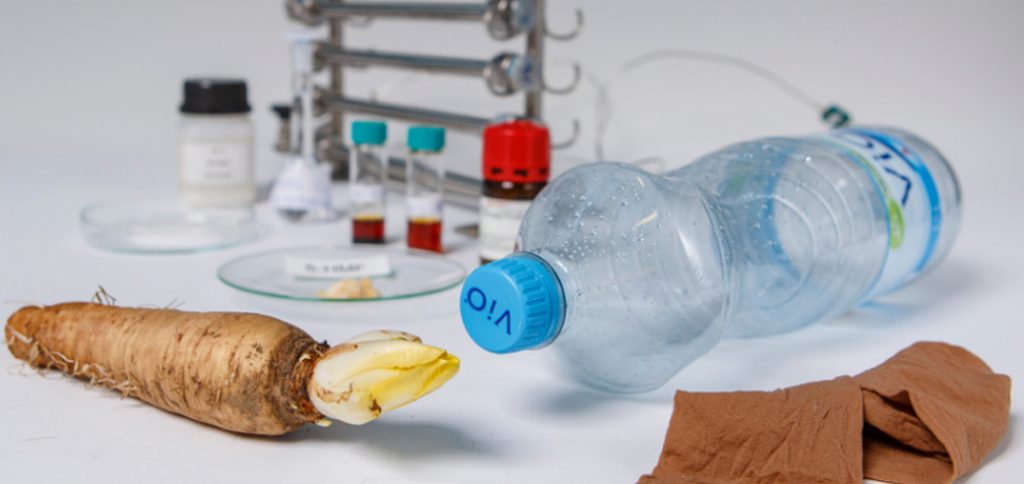Are bioplastics the future?

We hear more and more about bioplastics these days. But what exactly does this term mean? How much information do consumers already have about using bioplastics? And what benefits can the beverage packaging industry leverage from bioplastics today?
Let’s first start with some general information: The term “bioplastics” is not legally protected, and there’s no agreement on a definition yet. As a general rule, the term bioplastics applies to materials that are mostly, or exclusively, made from renewable resources. However, a distinction must be made between bio-based and biodegradable plastics. Bio-based plastics always derive from plant or animal sources rather than from such nonrenewable resources as oil. Biodegradable plastics, on the other hand, do not have to derive from renewable raw materials. As a result, bioplastics can be bio-based or biodegradable or both.
According to the market research institute Ceresana, around 300 million tons of plastic are produced each year. Only 1% constitutes bioplastics. This, however, is changing, and European Bioplastics is forecasting annual growth rates of 20% to 100% in coming years.
Bioplastics: from waste to raw materials
No research avenue is being left unexplored, and many include the creation of raw materials from waste. All kinds of materials are used for recycling, ranging from maize starch, wood chips, grass clippings, straw, algae waste and whey to potato pulp, orange peel and chicory waste. In carrying out this work, researchers strive to avoid competition with the food production industry.
Consumers don’t know enough about bioplastics
While companies constantly deal with bioplastics, consumers appear to be completely unaware of them. A survey carried out by Hannover University, clearly demonstrates this: 36.3% of respondents stated they had already heard of bioplastics while 56.7% said they weren’t familiar with the term. Only 7% claimed they knew its exact meaning. However, around two-thirds of participants indicated they believed all bioplastics were biodegradable. These results clearly demonstrate consumers need additional information.
PEF: chicory root has a new lease on life
This need for information is particularly important to successful, ongoing projects that would benefit from increased communication. Did you know that chicory root can be used to make PEF (polyethylene-furanoate) bottles? Disposal of this material, of which Europe produces approximately 800,000 tons annually, has been in composting facilities and biogas plants. In an earlier research project, Dr. Andrea Kruse from the University of Hohenheim succeeded in generating the key HMF (hydroxymethylfurfural) base chemicals required for making PEF from fructose. But, states Dr. Kruse, “Fructose is edible; it can be put to better use than generating HMF,” before then adding: “This does not, however, apply to chicory root. For a long time, the root has been considered waste. Furthermore, PEF packaging made from chicory HMF allows for thinner walls than petroleum-based PET, for example. That reduces transport costs and our ecological footprint.” The material is also designed to be suitable for both carbonated and noncarbonated drinks. Another key advantage chicory offers: PEF packaging features enhanced impermeability against such gases as carbon dioxide and oxygen. This means bottled beverages enjoy a particularly long shelf life.
BASF and Avantium also see a future for PEF. They recently founded a new joint venture, Synvina, that aims to produce and market PEF. They also intend to develop PEF bottles in collaboration with The Coca-Cola Company, Danone and Alpla.
Diverse packaging ideas
Naku, an Austrian company, has brought an equally interesting concept to market: a bottle made from PLA (polylactide). “This new material comprises 100% raw materials and consists of lactic acid,” says Managing Director and Founder Johann Zimmerman. According to the firm, the bottle is to be 10 times cheaper and 20 times lighter than glass and will be highly suitable for fresh fruit juice, smoothies and dairy products.
The “bio-packaging” bottle was not just exclusively created for the nonalcoholic beverages industry, however. For example, Erdbär, a fruit and vegetable juice manufacturer, offers an alternative. The Berlin-based company has released new squeeze pouches made using more than 80% renewable raw materials as part of its Freche Freunde kids’ product range. The composite material is said to be from sugarcane-based green PE and barrier PET HB. Both the cap and nozzle are made from green PE.
Stay informed and choose sustainable solutions
Industry experts are convinced that bioplastics might pave the way for options we couldn’t even dream of today, including packaging for nonalcoholic drinks. For this reason, it’s important to stay informed and ensure consumers receive a steady stream of information. After all, sustainable packaging can be used as both an advertising argument and a means to obtaining a competitive edge.
During drinktec, a wide array of perspectives can be taken to explore and discuss bioplastics. Organizers will also shed light on the degree to which bioplastic packaging can be easily processed in existing and future facilities. Join such a conversation in the Innovation Flow Lounge, the perfect setting for such dialogue. During the PETnology Europe trade conference as well as in the PETpoint exhibition area, you can learn more about the latest PET innovations and developments. This event will also feature interesting discussions on sustainable PET solutions.
Innovation Flow Lounge is supported by:
- Döhler
- FoodBev Media
- KHS
- Sahm GmbH
